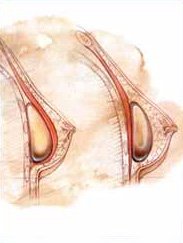The so-called subfascial implant placement is more about marketing buzz than it is good medicine. Women hearing about this on the Internet or, unfortunately, even from some in the medical community, should dig deeper to get to the facts. Successful breast augmentation surgical outcomes depend on it. Let’s look into the details.

Illustration from Myofascial -Therapy.co.uk We selected this illustration because it demonstrates the dimensional, web-like nature of fascial tissue. This is no place for a silicone or saline implant.
FASCIAL tissue is thin and very fibrous connective tissue that surrounds muscle throughout the body, including the pectoral muscle in the chest. Fascial tissue helps bundle muscle groups, blood vessels and nerves. Anyone who has ever skinned a chicken has seen fascial tissue. It’s that thin and amazingly stubborn layer of grizzly membrane over the muscle and meat. Similarly, in human anatomy, muscle and fascia are bound together. Attempts to separate the fascia and tissue to introduce an implant would be traumatic and ultimately ineffective.
Dr. Capizzi – along with most all capable, board-certified plastic surgeons – will advise that there are two optimum implant placement options: subglandular (between the pectoral muscle and breast tissue) and submuscular (under the pectoral muscle, which is wrapped in fascial tissue). Of these two, submuscular placement is generally the preferred approach. Medical data supports this. Submuscular placement reduces the risk of capsular contraction, rippling, malrotation and infection. Additionally, most radiologists will add that submuscular placement improves mammography; it is less likely that the implant will obstruct clear imaging of the breast tissue. Your research on implant placement may note that greater recovery time is needed for submuscular placement. Please know that if your surgeon is skilled, additional recovery time will not be required. Dr. Capizzi’s breast augmentation patients resume normal activity in less than a week’s time and rigorous exercise in as little as two weeks. Generally, simple Ibuprofen is used for pain management.

From The American Society for Aesthetic Plastic Surgery. LEFT: preferred sub-muscular placement. RIGHT: sub-glandular. Note that “sub-facscial” placement does not even merit discussion – because it is not an option.
Often a patient’s investigation of cosmetic breast surgery will take them to websites like the American Society for Aesthetic Plastic Surgery and the American Society of Plastic Surgeons. These are highly esteemed professional organizations. It should be noted that neither of these groups even mentions subfascial implant placement. Why? It is not good medicine.
The Journal of Plastic & Reconstructive Surgery is the premier professional journal of board-certified plastic surgeons. The October 2013 issue reports new, fact-base findings on the preeminence of submuscular implant placement in significantly reducing the incidence of capsular contracture, mentioned earlier. Capsular contracture refers to the irregular and deforming density of scar tissue surrounding an implant. Dr. Capizzi is one of eight surgeons participating in this five-year study and among the article’s authors.
In preparation for this blog communication, Dr. Capizzi and team undertook some due diligence and researched subfascial placement in medical literature, which does not include the popular press. At Stillwater, we are always open to new ideas. In fact, Dr. Capizzi is an innovator and leader in surgeries of the breast. Medical data on subfascial implant placement is sketchy and incomplete. To be specific, one German article reports on subfascial approach among a population of just 70 patients. The analysis is unclear. Another article touts the merits of subfascial placement and offers photographic documentation. Yet, the images clearly show an underarm incision with a split pectoral muscle. The bottom line: the FDA, professional surgical associations, implant manufacturers and the vast majority of information in implant literature do not even mention subfascial as a viable breast implant placement option. Buyer beware.
Our mission at Capizzi MD Plastic Surgery Center is to help patients become their best selves. Cosmetic breast augmentation is Dr. Capizzi’s specialty, thanks to expert training, commitment, and the confidence of so many patients over the last fifteen years of active practice. It is the doctor’s and the team’s responsibility to offer sound medical advice, and sometimes separate fact from fiction, medicine and marketing for enquiring patients.
